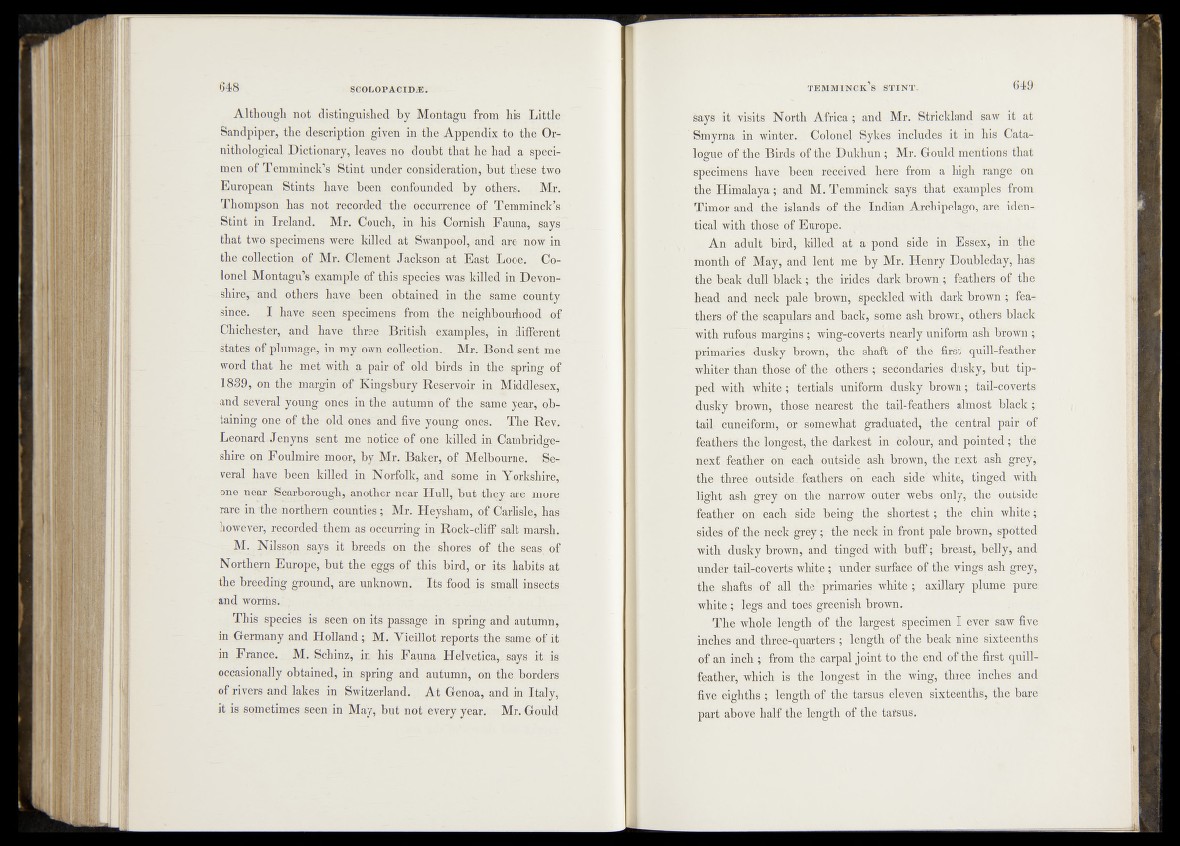
Although not distinguished by Montagu from his Little
Sandpiper, the description given in tbe-Appendix to the Ornithological
Dictionary, leaves no doubt that he had a specimen
of Temminck’s Stint under consideration,, but these two
European Stints have been confounded by others. . Mr.
Thompson has not recorded the occurrence of Temminck’s
Stint in Ireland. Mr. Couch, in his Cornish Fauna, sayiT
that two specimens were killed at Swanpoël, -and' are now in
the collection of Mr. Clement Jackson at East Lope,, Colonel
Montagu's example o f this species was, killed in Devonshire;
and others have, been obtained, in the; same county,
since. I have_ seen specimen^ from the »neighbourhood of
Chichester, and jbave three British-*-examples? in different
states of plumage, in my .’own collection., Mr. Bond sent me
word that he met with a pair of old birds in f|ie- spring of
1889, on the' margin of Kingsbury Reservoir in Middlesex,
and several young ones in the autumn of the same year, obtaining
one(vof the- old one&lmd five young .,p,n^.r The Rev:
Leonard Jenyns^sect me notice of one killeddn Cambridge-
shire on Foulmire moor, byT Mr, Baker, of Melbourne. . *Se^
veral have been killed in Norfolk, and some , in Yorkshire,
one near Scarborough, another near Hull, but they arp, jnore
rare in Ihenorthern counties ; = Mr. Heysham, .of Carlisle, has
however, jrecorded-ihem as occurring in Rock-cliff salt-marsh.
M. Nilsson s^ys it breeds on the shores of the seas<(bf
Northern Europe^ but the eggs of this bird, or its habits at
the breeding ground, are unknown. Its food is small insects
and worms. ,
This species is seen on its passage in spring and autumn,
in (Germany and Holland; M. Vieillot reports • the same of it
in France. M. Schinz, in his Fauna Helvetica^ says it is
occasionally obtained, in spring and autumn, on the borders
of rivers and lakes in; Switzerland., At Genoa, and in Italy*
it is sometimes seen in May, but not every year. Mr. Gould
Says- it -visits North Africa ; and Mr. Strickland saw it at
Smyrna in winter. ‘-Colonel Sykes includes it in his Catalogue
of the Birds of the Bukhun ; Mr. Gould mentions that
specimens haveÿîbeen. received here from a high range on
the Himalaya ; and M. Temminck' says that examples from
Timor and- the islands of the ; Indian Archipelago, are identical
with those of Europe. '
An;:adult bird, killed at'a'p o n d side in Essex, in the
month of May, and lent mo by Mr. Henry Doubleday, hâs
the beak dull black ; - the irides darkbrown ; feathers of the
head and, neck pale brown, speckled with dark brown ; feathers
of the“scapulars and back, some ash brown, others black
with rufous margins ; wing-covertd nearly uniform ash brown ;
primaries -dusky brown i the shaft .of thé first quill-feather
whiten than .-those of the others ;“ secondaries dusky, but tipped
with white ; -tettials uniform dusky brown; tail-coverts
■duskÿ brown, those nearest the tail-feathers almost, blacki
tail cuneiform, oh somewhat graduated,; the-central pair of
feathers .thé longest, -the darkest in colour,; and pointed ; the
next feather on. each- odtsidè ash brown, the next ash grey*
the three outsider-feathers on each side'white, tinged with
light ash grey On J f e harrow outer .webs, only* the outside
feather .on] each side; being the shortest ; the chin white ;:
sides Of the neck grey the neck in front pale brown, spotted
with dusky brown, and tinged with buff ; breast, bélly, and
undét tail-coverts white ; under surface of the wings ash grey,
tfie shafts of all the ’ primaries white ; axillary plumé pure;
white ; legs and toes greenish brown.
The whole length of the largest specimen I ever saw five
inches and three-quarters ; length of the beak nine sixteenths
of an inch ; from the carpal joint to the end of the first quill-
feather, which is the longest in the wing, three inches and
five eighths ; length of the tarsus éïeven sixteenths, the bare
part above half the length of the tarsus.